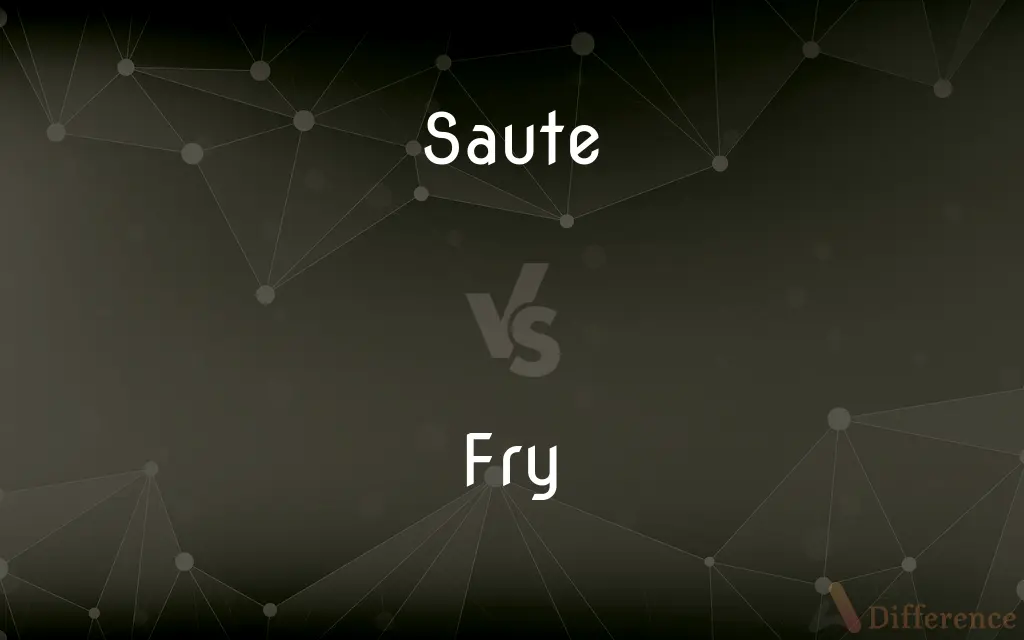Saute vs. Fry — What's the Difference?
By Fiza Rafique & Maham Liaqat — Updated on March 20, 2024
"Saute" is a quick cooking method using minimal oil and high heat, while "Fry" encompasses various techniques, often using more oil.

Difference Between Saute and Fry
Table of Contents
ADVERTISEMENT
Key Differences
Sauteing involves cooking food quickly in a small amount of oil or fat over relatively high heat. This method is characterized by its ability to preserve the texture and flavor of the food, often resulting in a slightly crisp exterior. Sauteing is ideal for tender cuts of meat, vegetables, and seafood, where the goal is to achieve a golden color and enhanced flavors without deep cooking. Whereas frying can refer to several cooking methods, including deep frying, pan-frying, and stir-frying, which can vary significantly in the amount of oil used and the cooking times. Frying methods aim to cook foods thoroughly, often resulting in a crispy or crunchy exterior and a fully cooked interior.
The amount of oil used is a distinguishing factor between sauteing and frying. Sauteing uses minimal oil, just enough to coat the bottom of the pan, facilitating a quick cook and light browning. On the other hand, frying, especially deep frying, involves submerging the food in hot oil, which can lead to a richer flavor and a more pronounced crispy texture but also a higher fat content in the finished dish.
Sauteing is often done over high heat with constant movement—either tossing the ingredients in the pan or stirring them—to ensure even cooking and prevent burning. This technique requires the cook's attention and is usually completed within minutes. Frying, depending on the method, might involve lower temperatures and longer cooking times, especially for deep frying, where the food is immersed in oil and cooked until it reaches the desired level of crispiness and doneness.
The choice between sauteing and frying often depends on the desired outcome of the dish. Sauteing is suited for dishes where the natural flavors and textures of the ingredients are to be highlighted, with a quick cook that retains much of the food's original texture and color. Frying, particularly deep frying, is chosen for dishes that benefit from a crunchy exterior and a rich flavor profile, often with a softer interior, like fried chicken or French fries.
Both sauteing and frying play vital roles in cooking, each bringing different textures, flavors, and characteristics to dishes. While sauteing is prized for its speed and ability to enhance the natural qualities of food, frying is valued for its versatility and the unique taste and texture it can impart to a wide variety of ingredients.
ADVERTISEMENT
Comparison Chart
Oil Usage
Minimal, just enough to coat the pan
Varies, from shallow to fully submerged in deep frying
Heat
High heat, quick cooking
Can vary, generally lower than sauteing, except for stir-frying
Cooking Time
Short, often a few minutes
Varies, longer for deep frying, shorter for pan or stir-frying
Technique
Constant movement, tossing or stirring
Depends on the method; can involve flipping or stirring
Texture Outcome
Light browning, preserves natural texture
Often results in a crispy or crunchy exterior
Ideal Foods
Tender meats, vegetables, seafood
Wide range, including meat, vegetables, doughs, and sweets
Compare with Definitions
Saute
Light browning, preserving texture.
Sauteing the shrimp preserved their tender texture.
Fry
Varied oil usage, from shallow to deep.
He fried the chicken until it was crispy and golden.
Saute
Ideal for tender ingredients.
The recipe called for the mushrooms to be sauteed briefly.
Fry
Technique varies by method.
Stir-frying the beef required constant stirring on high heat.
Saute
Quick cooking with minimal fat.
She sauteed the garlic until it was golden.
Fry
Can involve longer cooking times.
The doughnuts were fried slowly to perfect doneness.
Saute
High heat with constant movement.
The chef sauteed the vegetables, keeping them crisp.
Fry
Often results in a crispy texture.
The fried onions added a crunchy texture to the dish.
Saute
Enhances natural flavors.
Sauteing the spices released their aromatic flavors.
Fry
Suited for a wide range of foods.
From vegetables to sweets, frying is a versatile method.
Saute
To fry lightly in fat in a shallow open pan.
Fry
To cook over direct heat in hot oil or fat.
Saute
A dish of food so prepared.
Fry
(Slang) To destroy (electronic circuitry) with excessive heat or current
"a power surge to the computer that fried a number of sensitive electronic components" (Erik Sandberg-Diment).
Saute
Alternative form of sauté
Fry
To be cooked in a pan over direct heat in hot oil or fat.
Saute
Fry briefly over high heat;
Saute the onions
Fry
(Slang) To undergo execution in an electric chair.
Saute
Fried quickly in a little fat
Fry
A french fry
Ordered fries as a side dish.
Fry
A dish of a fried food.
Fry
A social gathering at which food is fried and eaten
A fish fry.
Fry
A recently hatched fish.
Fry
A young salmon living in fresh water that is older than an alevin and younger than a parr or smolt.
Fry
A young animal of certain other groups, such as frogs.
Fry
Pl. fry or fries An individual, especially a young or insignificant person
"These pampered public school boys ... had managed to evade the long prison sentences that lesser fry were serving" (Noel Annan).
Fry
A method of cooking food.
Fry
(transitive) To cook (something) in hot fat.
I am frying the eggs.
Fry
(intransitive) To cook in hot fat.
The eggs are frying.
Fry
(obsolete) to simmer; to boil
Fry
To be affected by extreme heat or current.
Fry
To suffer because of too much heat.
You'll fry if you go out in this sun with no sunblock on.
Fry
To be executed by the electric chair. Category:en:Capital punishment
He's guilty of murder — he's going to fry.
Fry
To destroy (something, usually electronic) with excessive heat, voltage, or current.
If you apply that much voltage, you'll fry the resistor.
Fry
A fried piece of cut potato.
Fry
A meal of fried sausages, bacon, eggs, etc.
Fry
The liver of a lamb.
Fry
A lamb or calf testicle.
Fry
A state of excitement.
To be in a fry
Fry
Young fish; fishlings.
Fry
Offspring; progeny; children; brood.
Fry
(archaic) A swarm, especially of something small.
A fry of children
Fry
The spawn of frogs.
Fry
A kind of sieve.
Fry
A drain.
Fry
To cook in a pan or on a griddle (esp. with the use of fat, butter, or olive oil) by heating over a fire; to cook in boiling lard or fat; as, to fry fish; to fry doughnuts.
Fry
To undergo the process of frying; to be subject to the action of heat in a frying pan, or on a griddle, or in a kettle of hot fat.
Fry
To simmer; to boil.
With crackling flames a caldron fries.
The frothy billows fry.
Fry
To undergo or cause a disturbing action accompanied with a sensation of heat.
To keep the oil from frying in the stomach.
Fry
A dish of anything fried.
Fry
A state of excitement; as, to be in a fry.
Fry
The young of any fish.
Fry
A swarm or crowd, especially of little fishes; young or small things in general.
The fry of children young.
To sever . . . the good fish from the other fry.
We have burned two frigates, and a hundred and twenty small fry.
Fry
English painter and art critic (1866-1934)
Fry
English dramatist noted for his comic verse dramas (born 1907)
Fry
A young person of either sex;
She writes books for children
They're just kids
`tiddler' is a British term for youngsters
Fry
Be excessively hot;
If the children stay out on the beach for another hour, they'll be fried
Fry
Cook on a hot surface using fat;
Fry the pancakes
Fry
Kill by electrocution, as in the electric chair;
The serial killer was electrocuted
Common Curiosities
Why is my sauteed food soggy?
Overcrowding the pan or using too low heat can result in steaming the ingredients instead of sauteing, leading to a soggy texture.
Can frying be done in a non-stick pan?
Yes, but for high-heat methods like stir-frying, a wok or a heavy-bottomed pan is often better suited to withstand the temperature.
Is sauteing healthier than frying?
Sauteing is often considered healthier due to the minimal use of oil, which can result in lower fat content in the final dish.
Can you reuse oil after frying?
Oil can be reused a few times after frying if it's strained and stored properly, though it may acquire flavors from the foods cooked in it.
Is deep frying always done at a lower temperature than sauteing?
Deep frying is done at a carefully controlled temperature that's often lower than the high heat used for sauteing to ensure even cooking throughout.
What are the key differences in flavor between sauteed and fried foods?
Sauteed foods tend to have a more natural flavor enhanced by quick cooking, while fried foods often have a richer taste due to the oil absorption.
What's the best pan for sauteing?
A wide, shallow pan with a heavy bottom, like a saute pan, is ideal for even heat distribution and room to move the ingredients.
How do you know when the oil is ready for frying?
You can test the oil's readiness by adding a small piece of food; if it sizzles and rises to the surface, the oil is ready.
Can you saute with any type of oil?
Yes, but oils with a high smoke point, like canola or vegetable oil, are preferred for their ability to withstand high heat without burning.
How do you reduce oil splatter when frying?
Use a splatter screen, maintain an appropriate oil temperature, and avoid adding wet ingredients to hot oil to reduce splattering.
Can sauteing achieve the same crispiness as frying?
Sauteing can achieve some browning and crispness but typically not to the same degree as frying, which fully immerses food in oil for a crispier texture.
Why do some recipes call for both sauteing and frying?
Combining techniques can develop deeper flavors and textures, such as sauteing aromatics for their flavor and then frying for a crispy texture.
Share Your Discovery

Previous Comparison
Ignorant vs. Arrogant
Next Comparison
Sopranino vs. SopranoAuthor Spotlight
Written by
Fiza RafiqueFiza Rafique is a skilled content writer at AskDifference.com, where she meticulously refines and enhances written pieces. Drawing from her vast editorial expertise, Fiza ensures clarity, accuracy, and precision in every article. Passionate about language, she continually seeks to elevate the quality of content for readers worldwide.
Co-written by
Maham Liaqat















































